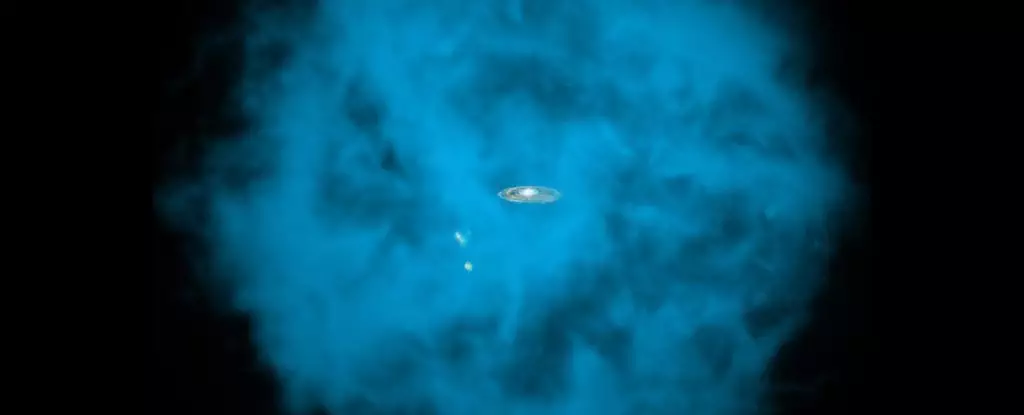For decades, astrophysicists have grappled with a conundrum that sits at the very core of our understanding of the Universe: the absence of approximately half of the visible matter that should exist in the cosmic expanse. This missing baryonic matter has long been a source of frustration and intrigue, as scientists struggled to unravel the riddle of its whereabouts. Recent breakthroughs have illuminated the landscape of this celestial drama, revealing that the missing matter is not lost but rather lurking in vast, invisible clouds of ionized hydrogen, a finding that could significantly enhance our comprehension of cosmic structures and evolution.
The New Methodology: Shedding Light on the Invisible
At the forefront of this revelation is a collaborative effort from an international array of astronomers and astrophysicists who have pioneered an innovative observational technique. By employing the cosmic microwave background (CMB)—the afterglow of the Big Bang—they have developed a method to detect these elusive clouds of hydrogen that shroud galaxies. The CMB serves as a cosmic backlight, allowing researchers to assess the interference of this ionized hydrogen on the light passing through it. This nuanced approach sheds new light on our understanding of how vast, diffuse hydrogen clouds interact with the underlying fabric of the Universe.
Utilizing a stacking technique, the researchers compiled data from over a million glowing red galaxies within an impressive radius of 8 billion light-years from the Milky Way. This method allows for the amplification of faint signals, leading to a clearer picture of the elusive hydrogen envelopes surrounding galaxies. Such discoveries not only provide evidence of the clouds’ existence but also suggest that these halos may extend far beyond current measurements, opening the door to a broader understanding of cosmic dynamics.
The Cosmic Puzzle of Baryonic Matter
It is crucial to recognize that baryonic matter, which is composed primarily of hydrogen, constitutes only a fraction of the Universe’s overall matter-energy composition—around 5%. Its counterparts, dark matter and dark energy, dominate the cosmic landscape, forming 27% and 68% of the Universe, respectively. The recognition that a staggering portion of baryonic matter was yet to be accounted for presents an urgent question: Where has all this hydrogen gone?
Prior to this recent study, the leading hypothesis speculated that much of this hydrogen was simply unobservable due to its tenuous existence within the intergalactic medium. Previous attempts to identify this material relied heavily on direct observation, which proved futile due to the faintness of the ionized hydrogen. The breakthrough, therefore, lies in the ability to ‘see’ the hydrogen by examining how it interacts with the light originating from the cosmic microwave background.
The Role of Supermassive Black Holes
Further complicating the narrative is the influence of supermassive black holes at the centers of galaxies. These enigmatic entities can emit powerful jets and winds that reshuffle the region’s gaseous components, pushing them away from the galactic core and into the hydrogen haloes. Such activity may not be uniform; indeed, evidence suggests that black holes experience episodic phases of activity. This variability could mean that black holes intermittently eject gas, affecting star formation and dictating the structure of the galaxies themselves.
The more significant halos observed could imply a correlation between the gas and the activities of supermassive black holes, suggesting a deeper interplay in galaxy evolution than previously understood. This interdependence presents a critical investigation point for astronomers, as understanding how black hole dynamics interact with baryonic matter could yield profound implications for the models that predict galaxy formation and behaviors across vast cosmic timescales.
Implications for Future Research
As the discoveries surrounding the missing baryonic matter unfold, they extend an invitation for a myriad of future research pathways. This new approach doesn’t merely fill a gap in our understanding but lays the groundwork for exploring the intricate relationship between visible matter and dark matter structures that weave throughout the cosmos.
The identification of these expansive hydrogen clouds points to a dynamic landscape where matter, both seen and unseen, interacts intricately to shape the Universe. Each new finding offers invaluable insights, challenging astronomers to refine their methodologies and theoretical frameworks. The road ahead is lined with questions: How do these findings reshape our cosmological models? What does the relationship between baryonic gases and dark matter filaments reveal about galactic evolution?
The excitement ignited by these revelations signifies not just a victory in the quest for knowledge but also the vast potential waiting to be unlocked as we continue our exploration of this magnificent and intricate Universe that we call home.


Leave a Reply